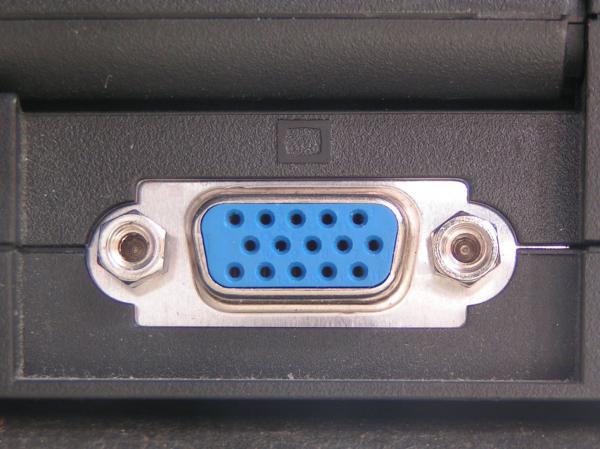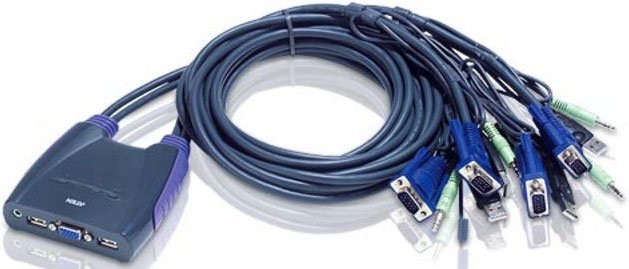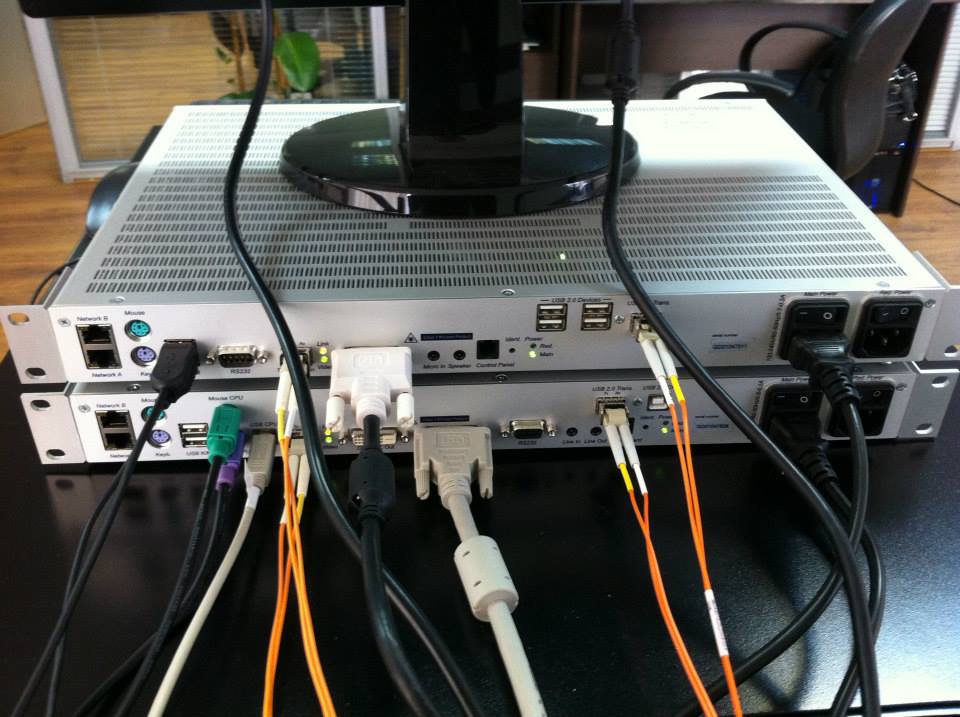
How to connect two computers to one monitor: instructions. How to exchange a display between two PCs connected to 1 monitor?
In this article you will learn how to connect two processors to one monitor.
Navigation
There are many reasons why you need to connect two computers to one monitor. For example, this may be a question of saving a place, resources, for presentation, or you just need a monitor and you do not want to buy another.
Whatever the reason, you can always connect two computers to one monitor.

The connection process involves the use of a relatively inexpensive routing device called the VGA switch. Follow the instructions in this article and find out how to connect two computers to one monitor.
How to use two computers with one screen?
You can simultaneously display the output from two PCs on one screen, but for this you will need a monitor that supports this function. This is a fairly common option for large -format displays of format 21: 9, which often allow you to assign one entrance to one side and the second entrance to the other.
One example is the ultra-cheat monitor LG 29EA93. This 29-inch display will allow you to simultaneously connect two computers, each of which works with a resolution of 1280 × 1080 pixels.
If you want to save more standard permission on your computers, you can try a rather strange Philips 19DP6QJNS monitor "Two in one". This device actually consists of two 19-inch panels built into one case, each of which individually supports a resolution of 1280 × 1024.
However, if you do this to try to save space, think about buying a pair of monitors with racks that can be installed. This will allow you to turn each screen 90 degrees in a vertical position and place them next to each other. This will take much less space on your table and will allow you to use two independent displays without the need to buy a fairly expensive ultrashirous or split monitor.
Another compact idea is to use a couple of brackets for the monitor to install a couple of displays above your table in a horizontal or upright position.
If you really do not need to run both computers at the same time, and you do not want to mess with the cables that switch the monitor between them, the best option is KVM switch (Read detailed information about it in the article below).
They are cheap enough and allow the use of the same monitor, a keyboard and a mouse with several computers. KVM switch allows you to cyclically switch between computers by pressing one button.
If both computers are on the same network, it can also be achieved using the KVM software switch.
Connecting two computers to one monitor using a VGA cable
- Make sure that the computer monitor and both devices support the VGA/SVGA video signal. If any of the devices does not support the VGA/SVGA video signal, you need to purchase an appropriate adapter for the compatibility of the device with VGA. For example, if you use a digital computer monitor, connect the VGA digital adapter to the port of DVI in the computer port.
- To connect the VGA and DVI, turn off both computers.
- Connect one end of the VGA cable to the port of VGA on the computer monitor.
- The VGA connector should be leveled so that the 15-pin connector is easily inserted into the 15-pin connectors in the VGA port.
- Turn the screws on the rear panel of the VGA connector clockwise to tighten them and fix the cable in place.
- Connect the other end of this cable of the VGA-separation to the output port of VGA (monitor) in the VGA connection window.

- Use another VGA cable to connect the VGA port on the first computer to the input port "one" or "A" VGA in the VGA connection window.
- Connect one end of the remaining VGA cable connector to the VGA port on the second computer. Connect the other end of this cable to the input port "2" or "B" VGA in the switching box.
- Connect the VGA connector to the outlet or power strip.
- Run both computers. Turn on the computer monitor.
- Turn on the VGA connection. Adjust the switch to position "one" or "A"to see the signal display on the first computer. Adjust the switch to position "2" or "B"to see the display of the signal of the second computer.

If you want to read a similar article on how to connect a computer to a monitor, then we recommend that you go through this link.
What is KVM switch, and what is it?
KVM - This is acronym for the keyboard, video (monitor) and mice, which is sometimes also called a PC switch or electronic switch. However, the KVM switch differs from the usual data switch.
The main function of the KVM switch is to control, switch and manage many PCs using one keyboard, monitor and mouse.
When a regular PC is launched, the operating system automatically tries to detect the keyboard and mouse signals.
After confirming the connection, the screen displays the initial page. As a result, the launch of one PC (CPU/Server) is confused with the launch of its keyboard and mouse.
If you need to manage several PCs, you need to purchase several sets of keyboard, mouse and monitor. This is not the best solution, since it not only takes up a lot of space, but also expensive.
Thus, the KVM switch is the best option for saving space, costs and increasing management efficiency.
When buying a KVM, the choice often depends on the number of PCs that you need to control.
KVM with several ports, as a rule, are more convenient to use without the need to install additional software.
They can also be easily controlled using hot keys or switching keys.
In addition, some of these KVM, equipped with only a few ports, do not even need an external power source. Due to the requirements for the environment (space), a high-level KVM switches with several ports can be installed on a server rack using only 1U or 2U in space. These KVM switches can also use IP networks to control the power points and control of the launch or turn off the PC.
The main function of the KVM switch is to use only one set of keyboard, monitor and mouse to launch several PCs. It is important that the KVM switch ensures that the keyboard and mouse signals reach each PC, and that during the switching it does not affect the PC processors.

The KVM switch also knows how to provide stable video resolution, support several computer platforms and operating systems and be able to interact with many different keyboard brands and mice.
One KVM switch can provide only two TsP ports, while the installation of several KVM-redeemers can support more than 4000 TsP ports.
As the number of connected computers increases, the complexity of control also increases to provide functions such as remote control, multiple segmentation and high level security.
The remote control uses KVM switches with hardware controls such as Pcanywhere, VNC, Openssh and Microsoft Telnet Service.
Previously, KVM was mainly used in server rooms and information centers equipped with several servers. The average middle -sized server room can contain from 16 to 32 servers, while a larger server room may contain more than 100 servers.

Some basic terms for KVM switch specifications include:
- Ports. The number of ports is indicated by the number of PCs that can be connected to KVM. For example, for an 8-port KVM switch, one keyboard, a monitor and a mouse can control up to 8 PC. Currently, the most common number of ports equipped with KVM switches is 2, 4, 8, 16 or 32 ports.
For more convenient management and launch of several PCs, some KVM have various functions that help control, such as hot keys, screen menu (OSD) and broadcasting. Some innovative KVM companies also developed patented built -in basic logical chips to increase the operational stability and effectiveness of the signal.
- Console. The console is an input/output station for a computer, including a monitor, a keyboard and a mouse (if necessary). However, in terms of KVM, this applies to management, which is used to control the keyboard, monitor and mouse of the PC. Typically, the console has three different ports for the keyboard, mouse and monitor. Specifications for the keyboard and mouse-deposit-USB and PS/2, and for the monitor-DVI and HDB 15.
Note. Some KVM consoles that support audio also have ports for microphone and speakers. KVM, specially designed for use with computers Sun and Mac, have different ports.
- CPU/KVM. This term refers to the connected PC. One CPU port on KVM has three different signals (keyboard, mouse and monitor) for connecting to PC ports.
To save on the specifications of the material (BOM) and increase the ease of installation, some companies produce their own proprietary cables that combine the aforementioned three cables into one.
The use of three cables in one simplifies the space on the desktop, reducing the mess of several cables. Cable signals can easily affect interference from external and even internal sources. Therefore, to minimize these problems, it is recommended to choose a professional KVM brand.
Note. KVM, supporting audio, also have ports for microphone and speakers available at the CPU/KVM port.
KVM switches can be divided as follows:
- Small office and home office (soho)
- Small and medium -sized businesses (SMB)
- Large or high -quality global corporate level KVM
Many KVM companies then divide high -class KVM into high -performance KVM with remote control and KVM with nearby management.
